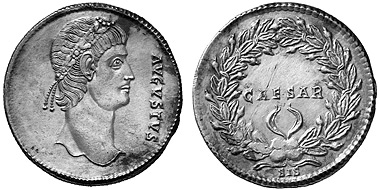by courtesy of Dr. Hans Voegtli / ACAMA
CONSTANTINE THE GREAT, 307-337. Silver medallion of 4 Siliquae, Siscia, 336-337. AVGVSTVS Rosette-diademed head of Constantine r. Rv. CAESAR in laurel wreath, in exergue, SIS 13,20 g. RIC VII, 459, 259. Scratch on rev., otherwise extremely fine.
This impressive piece belongs to a small series of silver medallions celebrating the vicennalia of Constantine II, the eldest surviving son of Constantine the Great, in 336. Two different medallions were issued on that occasion. This piece featuring a portrait of Constantine the Great, and a matching piece with a portrait of Constantine II, the obverse inscription CAESAR, and XX within a wreath on the reverse. The series commemorates the 20th anniversary (vicennalia) of Constantine’s II designation as Caesar.
Celebration of such jubilees was a primarily religious ceremony, dating back to traditions from Republican times. Every year, the consuls took vows pro salute rei publicae – for the safety of the commonwealth – and fulfilled at the same time the vows of their predecessors, each sacrificing a white bull to Jupiter. Since the time of Augustus, vows for the wellbeing of the emperor had been added. Jubilees, such as the 20th anniversary, were celebrated in especially spectacular fashion.
On the occasion of these celebrations, not only Jupiter was “bribed”, but the soldiers. Since the time of Claudius, it has become customary to bestow substantial donations upon the soldiers, not only at each emperor’s accession, but also on major ceremonial occasions such as jubilees. In the case of Constantine’s II vicennalia, two medallions would have been distributed to each praepositus – leader of a military unit – one portraying the father, the other the son. Our medallion was worth 12 scruple of gold. One solidus had the weight of 4 scruples meaning two of these medallions were worth 6 solidi or 5 old aurei. According to the Oxyrynchus papyrus, that was the amount of money paid to a praepositus in Constantinian times on the occasion of a jubilee.
The two medallions had been minted to convey an imperial message: that Constantine II was Caesar under his father, and that his 20th anniversary as Caesar was being celebrated. But Constantine II had two brothers – Constans and Constantius – who were also Caesars. Why then such an impressive medallion honored only Constantine II? The answer lies in the principle of tetrarchy, established by Diocletian half a century earlier, which involved having two Augusti and two Caesars at any one time. Each man ruled his own section of the empire. Constantine had let this system lapse, becoming sole emperor after his victory over his co-emperor Licinius. However, Constantine intended to divide the empire five ways upon his death, among his three sons and two nephews, with Constantine II as the senior Augustus to make the final decisions in cases of dispute. That is why Constantine’s II role was stressed.
Head of Constantine the Great. Part of a bronze statue. Musei Capitolini / Rome. Wikipedia.
Constantine I died on May 22, 337, before he had finished arrangements
for the succession. His relatives soon fell out among themselves. In
340, Constantine II was killed during an invasion of Italy, part of his
brother Constans’ share of the empire. His corpse was thrown into the
river Alsa.
Literature:
P. Bastien, Monnaie et Donativa au Bas-Empire, Wetteren 1988.
A. Demandt, Die Spätantike, Handbuch der Altertumswissenschaften 3 / 6, München 1989.







